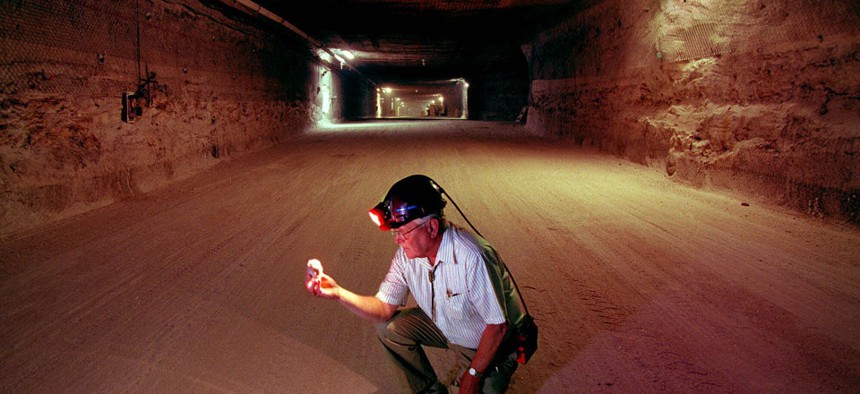Underground Plutonium Waste Plant Hit by Radiation Leak and Fire

Sandia National Laboratories Senior Fellow Wendell Weart examines a salt crystal from the floor of one of the deep underground salt chambers excavated for transuranic nuclear waste storage at the Waste Isolation Pilot Plant east of Carlsbad, N.M. Sandia National Laboratories/AP File Photo
Facility stores 3.2 million cubic feet of waste in salt caverns.
The country’s only underground nuclear waste storage site, located 26 miles southeast of Carlsbad, N.M., experienced a radiation leak last Friday, ten days after an underground vehicle caught fire at the facility.
The Energy Department’s Waste Isolation Pilot Plant, estimated to have cost more $1 billion to develop, went into operation in 1999 and stores plutonium-contaminated waste in salt caverns 2,150 feet below the surface.
Last Friday an air monitor detected airborne radiation in the facility. “No contamination has been found on any equipment, personnel or facilities," Energy said in a press release. "Any possible release is minimized by the highly protective filtration system that is designed to filter any air leaving the WIPP repository.”
On Feb. 5, an underground vehicle used to transport salt in the facility caught fire, all personnel were evacuated and “multiple employees” were transported to a local hospital for smoke inhalation, Energy said.
Don Hancock, director of the Nuclear Waste Safety Program at the Southwest Research and Information Center, a nuclear watchdog group in Albuquerque, said WIPP currently stores 3.2 million cubic feet of plutonium-contaminated waste generated during the development and manufacture of nuclear weapons by the Defense Department. The bulk of it is stored in drums that can be “contact handled” by workers, Hancock said. An Energy fact sheet describes the waste as “clothing, tools, rags, residues, debris, soil and other items contaminated with radioactive elements.”
WIPP tracks the location of each waste container stored in the facility with a waste data system that also identifies the physical, chemical and radiological properties of the waste.
Hancock said even the smallest particle of plutonium can cause lung cancer if inhaled.
WIPP’s sophisticated air filtration system has four separate ventilation circuits and probes that sample effluent air as it is exhausted from the repository, Energy said. The ventilation system automatically switched to “filtration mode” to capture any radioactive particles when airborne radiation was detected last Friday, the department said.
Hancock said last week's leak was the first in the history of the plant and, along with the fire, calls into question the safety of the facility. He said Energy has become complacent and has also shifted its focus from storage of low level waste to potential storage of “hot” waste precluded by the legislation that authorized WIPP.
Get the Nextgov iPhone app to keep up with government technology news.






